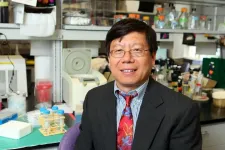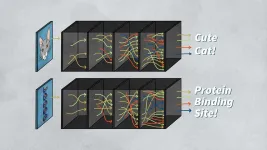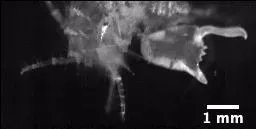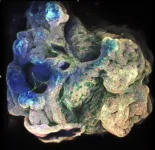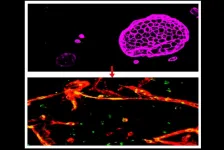Radiative cooling and solar heating from one system, no electricity needed
Study describes passive cooling system that aims to help impoverished communities, reduce cooling and heating costs, lower CO2 emissions
2021-02-08
(Press-News.org) BUFFALO, N.Y. -- Passive cooling, like the shade a tree provides, has been around forever.
Recently, researchers have been exploring how to turbo charge a passive cooling technique -- known as radiative or sky cooling -- with sun-blocking, nanomaterials that emit heat away from building rooftops. While progress has been made, this eco-friendly technology isn't commonplace because researchers have struggled to maximize the materials' cooling capabilities.
New research led by University at Buffalo engineers makes significant progress in this area.
A study published Feb. 8 in the journal Cell Reports Physical Science describes a uniquely designed radiative cooling system that:
Lowered the temperature inside a test system in an outdoor environment under direct sunlight by more than 12 degrees Celsius (22 degrees Fahrenheit).
Lowered the temperature of the test box in a laboratory, meant to simulate the night, by more than 14 degrees Celsius (25 degrees Fahrenheit).
Simultaneously captured enough solar power that can be used to heat water to about 60 degrees Celsius (140 degrees Fahrenheit).
While the system tested was only 70 centimeters (27.5 inches) squared, it could eventually be scaled up to cover rooftops, engineers say, with the goal of reducing society's reliance on fossil fuels for cooling and heating. It also could aid communities with limited access to electricity.
"There is a great need for heating and cooling in our daily life, especially cooling in the warming world," says the study's lead author Qiaoqiang Gan, PhD, professor of electrical engineering in the UB School of Engineering and Applied Sciences.
The research team includes Zongfu Yu, PhD, University of Wisconsin-Madison; Boon Ooi, PhD, King Abdullah University of Science and Technology (KAUST) in Saudi Arabia; and members of Gan's lab at UB, and Ooi's lab at KAUST.
System design and materials key to success
The system consists of what are essentially two mirrors, made of 10 extremely thin layers of silver and silicon dioxide, which are placed in a V-shape.
These mirrors absorb incoming sunlight, turning solar power from visible and near-infrared waves into heat. The mirrors also reflect mid-infrared waves from an "emitter" (a vertical box in between the two mirrors), which then bounces the heat they carry into the sky.
"Since the thermal emission from both surfaces of the central thermal emitter is reflected to the sky, the local cooling power density on this emitter is doubled, resulting in a record high temperature reduction," says Gan.
"Most radiative cooling systems scatter the solar energy, which limits the system's cooling capabilities," Gan says. "Even with a perfect spectral selection, the upper limit for the cooling power with an ambient temperature of 25 degrees Celsius is about 160 watts per square meter. In contrast, the solar energy of about 1000 watts per square meter on top of those systems was simply wasted."
Spinoff company aims to commercialize technology
Gan co-founded a spinoff company, Sunny Clean Water LLC, which is seeking partners to commercialize this technology.
"One of the key innovations of our system is the ability to separate and retain the solar heating and radiative cooling at different components in a single system," says co-first author Lyu Zhou, a PhD candidate in electrical engineering in the School of Engineering and Applied Sciences. "During the night, radiative cooling is easy because we don't have solar input, so thermal emissions just go out and we realize radiative cooling easily. But daytime cooling is a challenge because the sun is shining. In this situation, you need to find strategies to separate solar heating from the cooling area."
The work builds upon previous research Gan's lab led that involved creating a cone-shaped system for electricity-free cooling in crowded cities to adapt to climate change.
"The new double-sided architecture realized a record local cooling power density beyond 280 watts per square meter. Under standard atmospheric pressure with no vacuum thermal isolation, we realized a temperature reduction of 14.5 degrees Celsius below the ambient temperature in a laboratory environment, and over 12 degrees Celsius in an outdoor test using a simple experimental system," says the other co-first author, Haomin Song, PhD, a research assistant professor of electrical engineering in the School of Engineering and Applied Sciences.
"Importantly, our system does not simply waste the solar input energy. Instead, the solar energy is absorbed by the solar spectral selective mirrors, and it can be used for solar water heating, which is widely used as an energy efficient device in developing countries," says Gan. "It can retain both the solar heating and radiative cooling effects in a single system with no need of electricity. It's really sort of a 'magic' system of ice and fir."
The research team will continue to investigate ways to improve the technology, including examining how to capture enough solar power to boil water, making it suitable for drinking.
INFORMATION:
The work was supported by funding from the U.S. National Science Foundation's Thermal Transport Processes program.
[Attachments] See images for this press release:
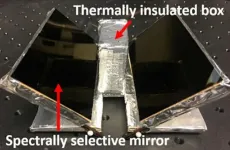
ELSE PRESS RELEASES FROM THIS DATE:
2021-02-08
Ebola and Marburg are among the most deadly viruses, with mortality rates from these infections ranging from 25% to 90%. While no drugs currently are available on the market to prevent infection from these viruses -- they belong to a category of viruses called filoviruses, which are known to cause hemorrhagic fever -- researchers have identified a few small drug molecules that can block filoviruses from infecting cells by occupying a single site on a glycoprotein in the virus.
Now, researchers at the END ...
2021-02-08
Cold Spring Harbor Laboratory (CSHL) Assistant Professor Peter Koo and collaborator Matt Ploenzke reported a way to train machines to predict the function of DNA sequences. They used "neural nets", a type of artificial intelligence (AI) typically used to classify images. Teaching the neural net to predict the function of short stretches of DNA allowed it to work up to deciphering larger patterns. The researchers hope to analyze more complex DNA sequences that regulate gene activity critical to development and disease.
Machine-learning researchers can train a brain-like "neural net" computer to recognize objects, ...
2021-02-08
COLUMBUS, Ohio - We know that what happens in the mouth doesn't stay in the mouth - but the oral cavity's connection to the rest of the body goes way beyond chewing, swallowing and digestion.
The healthy human oral microbiome consists of not just clean teeth and firm gums, but also energy-efficient bacteria living in an environment rich in blood vessels that enables the organisms' constant communication with immune-system cells and proteins.
A growing body of evidence has shown that this system that seems so separate from the rest of our bodies is actually highly influential on, and influenced by, our overall health, said Purnima Kumar, professor of periodontology at The Ohio State University, speaking at a science conference this week.
For example, type 2 diabetes has long ...
2021-02-08
New research finds caffeine consumed during pregnancy can change important brain pathways that could lead to behavioral problems later in life. Researchers in the Del Monte Institute for Neuroscience at the University of Rochester Medical Center (URMC) analyzed thousands of brain scans of nine and ten-year-olds, and revealed changes in the brain structure in children who were exposed to caffeine in utero.
"These are sort of small effects and it's not causing horrendous psychiatric conditions, but it is causing minimal but noticeable behavioral issues that should make us consider long term effects ...
2021-02-08
One of humanity's biggest challenges right now is reducing our emissions of greenhouse gases into the atmosphere. Research groups worldwide are trying to find ways to efficiently separate carbon dioxide (CO2) from the mixture of gases emitted from industrial plants and power stations. Among the many strategies for accomplishing this, membrane separation is an attractive, inexpensive option; it involves using polymer membranes that selectively filter CO2 from a mix of gases.
Recent studies have focused on adding low amounts of metal-organic frameworks (MOFs) into polymer matrices to enhance their properties. MOFs are compounds made of a metallic center bonded to organic molecules in a very orderly fashion, producing porous crystals. When added to polymer ...
2021-02-08
DURHAM, N.C. -- The world's most technologically advanced robots would lose in a competition with a tiny crustacean.
Just the size of a sunflower seed, the amphipod Dulichiella cf. appendiculata has been found by Duke researchers to snap its giant claw shut 10,000 times faster than the blink of a human eye.
The claw, which only occurs on one side in males, is impressive, reaching 30% of an adult's body mass. Its ultrafast closing makes an audible snap, creating water jets and sometimes producing small bubbles due to rapid changes in water pressure, a phenomenon known ...
2021-02-08
Bark beetle outbreaks and wildfire alone are not a death sentence for Colorado's beloved forests--but when combined, their toll may become more permanent, shows new research from the University of Colorado Boulder.
It finds that when wildfire follows a severe spruce beetle outbreak in the Rocky Mountains, Engelmann spruce trees are unable to recover and grow back, while aspen tree roots survive underground. The study, published last month in Ecosphere, is one of the first to document the effects of bark beetle kill on high elevation forests' recovery from wildfire.
"The fact that Aspen is regenerating prolifically after wildfire is not a surprise," said Robert Andrus, who conducted ...
2021-02-08
A team of engineers and scientists has developed a method of 'multiplying' organoids: miniature collections of cells that mimic the behaviour of various organs and are promising tools for the study of human biology and disease.
The researchers, from the University of Cambridge, used their method to culture and grow a 'mini-airway', the first time that a tube-shaped organoid has been developed without the need for any external support.
Using a mould made of a specialised polymer, the researchers were able to guide the size and shape of the mini-airway, grown from adult mouse stem cells, and then remove it from the mould when it reached ...
2021-02-08
DANVILLE, Pa. - Researchers at Geisinger have found that a computer algorithm developed using echocardiogram videos of the heart can predict mortality within a year.
The algorithm--an example of what is known as machine learning, or artificial intelligence (AI)--outperformed other clinically used predictors, including pooled cohort equations and the Seattle Heart Failure score. The results of the study were published in Nature Biomedical Engineering.
"We were excited to find that machine learning can leverage unstructured datasets such as medical images and videos to improve on a wide range of clinical prediction models," said Chris Haggerty, Ph.D., co-senior author and assistant ...
2021-02-08
A type of cell derived from human stem cells that has been widely used for brain research and drug development may have been leading researchers astray for years, according to a study from scientists at Weill Cornell Medicine and Columbia University Irving Medical Center.
The cell, known as an induced Brain Microvascular Endothelial Cell (iBMEC), was first described by other researchers in 2012, and has been used to model the special lining of capillaries in the brain that is called the "blood-brain barrier." Many brain diseases, including brain cancers as well as degenerative ...
LAST 30 PRESS RELEASES:
[Press-News.org] Radiative cooling and solar heating from one system, no electricity needed
Study describes passive cooling system that aims to help impoverished communities, reduce cooling and heating costs, lower CO2 emissions

